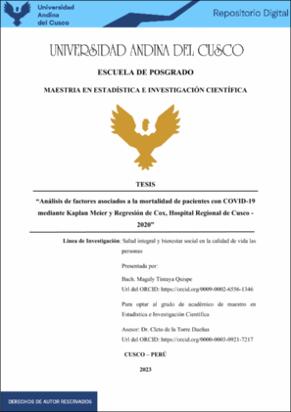| dc.contributor.advisor | De la Torre Dueñas, Cleto | |
| dc.contributor.author | Tintaya Quispe, Magaly | |
| dc.date.accessioned | 2024-03-06T21:17:30Z | |
| dc.date.available | 2024-03-06T21:17:30Z | |
| dc.date.issued | 2023-12-07 | |
| dc.identifier.uri | https://hdl.handle.net/20.500.12557/6122 | |
| dc.description.abstract | El objetivo de esta investigación fue analizar los factores asociados a la mortalidad de pacientes
con COVID-19 en el Hospital Regional de Cusco durante 2020. Se aplicaron las técnicas
estadísticas de Kaplan Meier y Regresión de Cox. El diseño del estudio fue básico, de alcance
descriptivo-correlacional, no experimental, de corte longitudinal y retrospectivo. Se trabajó con
una población de 1775 pacientes, de los cuales se seleccionaron 316 historias clínicas mediante
un muestreo aleatorio simple, teniendo en cuenta criterios de inclusión y exclusión.
El análisis demostró que la edad es un factor determinante en la mortalidad por COVID-19:
pacientes mayores de 60 años presentan un riesgo 1,836 veces mayor que aquellos entre 29 y
59 años. Además, los hombres tienen un riesgo 2,017 veces superior al de las mujeres. Síntomas
como tos seca, ageusia/anosmia y dolor de pecho están fuertemente vinculados con un
desenlace fatal. En relación con las comorbilidades, tanto la obesidad como la insuficiencia
renal mostraron una correlación significativa con la mortalidad, ya que sus p-valores fueron
menores al nivel de significancia establecido (0.05). La supervivencia media se determinó en
16.83 días, observándose una marcada disminución en la tasa de supervivencia durante el
primer mes. Otras comorbilidades, como la hipertensión, diabetes mellitus tipo 2 y enfermedad
pulmonar crónica, incrementaron el riesgo de mortalidad. Sin embargo, enfermedades
cardiovasculares e inmunosupresión no mostraron un impacto significativo.
Esta investigación subraya la importancia de tener en cuenta una combinación de factores
demográficos, características clínicas y comorbilidades, al determinar el tratamiento y
pronóstico de pacientes con COVID-19 en el Hospital Regional de Cusco. | es_PE |
| dc.description.abstract | The objective of this research was to analyze the factors associated with the mortality of
patients with COVID-19 at the Cusco Regional Hospital during 2020. The statistical techniques
of Kaplan Meier and Cox Regression were applied. The design of the study was basic, with a
descriptive-correlational scope, non-experimental, longitudinal, and retrospective. We worked
with a population of 1,775 patients, from which 316 medical records were selected through
simple random sampling, taking into account inclusion and exclusion criteria.
The analysis showed that age is a determining factor in COVID-19 mortality: patients over 60
years old have a 1.836 times higher risk than those between 29 and 59 years old. In addition,
men have a 2.017 times higher risk than women. Symptoms such as dry cough,
ageusia/anosmia, and chest pain are strongly linked to a fatal outcome. Regarding
comorbidities, both obesity and kidney failure showed a significant correlation with mortality,
as their p-values were less than the established significance level (0.05). The average survival
was determined to be 16.83 days, with a marked decrease in the survival rate during the first
month. Other comorbidities, such as hypertension, type 2 diabetes mellitus, and chronic lung
disease, increased the risk of mortality. However, cardiovascular diseases and
immunosuppression did not show a significant impact.
This research underscores the importance of considering a combination of demographic
factors, clinical characteristics, and comorbidities when determining the treatment and
prognosis of patients with COVID-19 at the Cusco Regional Hospital. | en_US |
| dc.format | application/pdf | es_PE |
| dc.language.iso | spa | es_PE |
| dc.publisher | Universidad Andina del Cusco | es_PE |
| dc.rights | info:eu-repo/semantics/restrictedAccess | es_PE |
| dc.rights.uri | https://creativecommons.org/licenses/by-nc-nd/4.0/ | es_PE |
| dc.subject | Supervivencia | es_PE |
| dc.subject | Kaplan Meier | es_PE |
| dc.subject | Regresión de Cox | es_PE |
| dc.subject | Características clínicas y demográficas | es_PE |
| dc.title | Análisis de factores asociados a la mortalidad de pacientes con COVID-19 mediante Kaplan Meier y Regresión de Cox, Hospital Regional de Cusco 2020 | es_PE |
| dc.type | info:eu-repo/semantics/masterThesis | es_PE |
| thesis.degree.name | Maestra en Estadística e Investigación Científica | es_PE |
| thesis.degree.grantor | Universidad Andina del Cusco. Escuela de Pos Grado | es_PE |
| thesis.degree.discipline | Estadística e Investigación Científica | es_PE |
| dc.publisher.country | PE | es_PE |
| dc.subject.ocde | https://purl.org/pe-repo/ocde/ford#1.01.03 | es_PE |
| renati.advisor.dni | 23988416 | |
| renati.advisor.orcid | https://orcid.org/0000-0003-0921-7217 | es_PE |
| renati.author.dni | 42051716 | |
| renati.discipline | 542057 | es_PE |
| renati.juror | Chacón Sánchez, Victor | |
| renati.juror | Rivas Mago, Lornel Antonio | |
| renati.juror | Zuniga Blanco, Arturo | |
| renati.juror | Alvarez Jauregui, Guido | |
| renati.level | https://purl.org/pe-repo/renati/level#maestro | es_PE |
| renati.type | https://purl.org/pe-repo/renati/type#tesis | es_PE |





